
Quercus georgiana, the Georgia oak or Stone Mountain oak, is a rare deciduous red oak, native to the southeastern United States.

Allium validum is a species of flowering plant commonly called swamp onion, wild onion, Pacific onion, or Pacific mountain onion. It is native to the Cascade Range, to the Sierra Nevada, the Rocky Mountains, and other high-elevation regions in California, Oregon, Washington, Nevada, Idaho and British Columbia. It is a perennial herb and grows in swampy meadows at medium and high elevations.

Scutellaria galericulata, the common skullcap, marsh skullcap or hooded skullcap, is a hardy perennial herb native to northern areas of the Northern Hemisphere, including Europe, Asia, and almost all of Canada. It is a member of the mint family. The form is upright and is usually 20-45 centimeters in height, sometimes reaching up to 80 cm. It is a wetland-loving species and grows along fens and shorelines. The blue flowers are 1 to 2 centimeters long. The flowers are in pairs and are all on the same side of the stem. The flowers do not appear at the top of the stem.

Hypericum tortuosum is a species of flowering plant in the genus Hypericum. It is found only in Socotra, Yemen, where it is endemic. The species is an apomorphic relative of the other Socotran species in Hypericum sect. Triadenioides and is most closely related to Hypericum scopulorum. Its natural habitats are subtropical or tropical dry forests and subtropical or tropical dry shrubland.
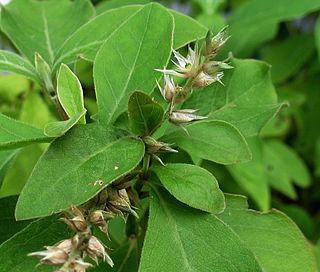
Achyranthes mutica is a species of plant in the family Amaranthaceae. It is endemic to Hawaii. It is a perennial shrub that grows up to 2 ft (0.61 m) tall. Its natural habitats are dry forests and subtropical or tropical dry shrubland. It is threatened by habitat loss.
Magnolia ovoidea is a species of flowering plant in the family Magnoliaceae. It is endemic to China. There are only four small subpopulations of this critically endangered species.
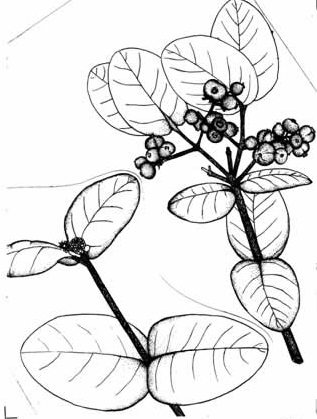
Myrcia sintenisiana is a species of flowering plant in the family Myrtaceae. It is endemic to Puerto Rico, where it is limited to the Luquillo Mountains. It occurs in El Yunque National Forest in dwarf forest habitat on wet mountain ridges. Its common name is beruquillo.
Melicope paniculata, the Lihue melicope, is a rare species of tree in the family Rutaceae. It is endemic to the Hawaiian Islands. Like other Hawaiian Melicope, this species is known as alani.
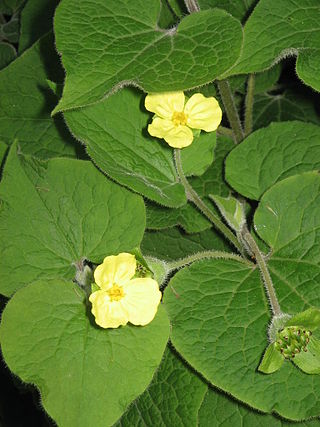
Saruma is a monotypic genus of flowering plants in the family Aristolochiaceae containing the single species Saruma henryi. It is endemic to China, where it occurs in Gansu, Guizhou, Hubei, Jiangxi, Shaanxi, and Sichuan.

Alisma lanceolatum is a species of aquatic plant in the water plantain family known by the common names lanceleaf water plantain and narrow-leaved water plantain. It is widespread across Europe, North Africa and temperate Asia. It is naturalized in Australia, New Zealand, Oregon, California and British Columbia. It is considered a noxious weed in some places.

Alopecurus aequalis is a common species of grass known as shortawn foxtail or orange foxtail. It is native to much of the temperate Northern Hemisphere from Eurasia to North America. It is most commonly found in areas near fresh water, such as the margins of ponds and ditches.
Astragalus leucolobus is a species of milkvetch known by the common names Bear Valley milkvetch and Bear Valley woollypod.
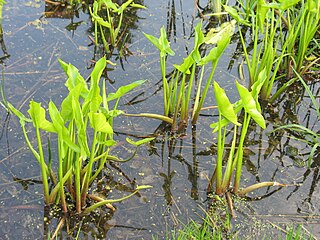
Peltandra virginica is a plant of the arum family known as green arrow arum and tuckahoe. It is widely distributed in wetlands in the eastern United States, as well as in Quebec, Ontario, and Cuba. It is common in central Florida including the Everglades and along the Gulf Coast. Its rhizomes are tolerant to low oxygen levels found in wetland soils. It can be found elsewhere in North America as an introduced species and often an invasive plant.
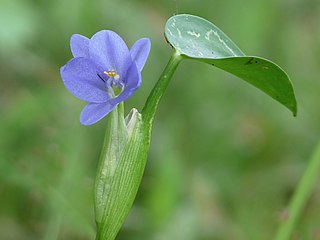
Monochoria vaginalis is a species of flowering plant in the water hyacinth family known by several common names, including heartshape false pickerelweed and oval-leafed pondweed.
Cyanea eleeleensis was a rare species of flowering plant in the bellflower family known by the common name Eleele cyanea. It was endemic to Kauai, where it has been declared extinct. It was federally listed as a critically endangered species of the United States in 2010. Like other Cyanea it is known as haha in Hawaiian.
Dubautia kenwoodii, the Kalalau rim dubautia, is an "extremely rare" species of flowering plant in the family Asteraceae. It is endemic to Hawaii where it is known only from the island of Kauai. Only one plant has ever been seen: the type specimen. A part of this plant was collected in 1991 and the individual was described as a new species in 1998. It was federally listed as an endangered species of the United States in 2010. Like other Dubautia this plant is known as na`ena`e.
Celtis madagascariensis is a species of flowering plant endemic to Madagascar.

Sideritis cypria, the Cyprus ironwort, is a species of flowering plant in the family Lamiaceae. Erect perennial herb with a woody base, 60 cm high, with densely hairy tetragonal shoots. Leaves, opposite, simple, obscurely serrate, densely hairy, thick, oblanceolate, 3-12 x 1–5 cm. Flowers in verticillasters subtended by the cup-like bracts, zygomorphic, corolla bright yellow. Flowers from June to August. Fruit of 4 nutlets.

Gladiolus triphyllus, the three-leaved gladiolus, is an erect perennial herb, 15–30 cm high, glabrous, glaucous, with an ovoid corm. Leaves usually 3 or 4, alternate, simple, entire, linear, the two lower 10-30 x 0.3-0.5 cm, the upper much reduced. The flowers are on a spike, zygomorphic, perianth of 6 petaloid parts, 2.5–3 cm long, pale or dark rose pink, scented only in the afternoon, bracts 1.5–3 cm long. It flowers from March to May. The fruit is a capsule.

Tulipa cypria, the Cyprus tulip, is a tulip, an erect perennial bulbous herb, 15–40 cm high, with glabrous, glaucous leaves. It has four leaves which are alternate, simple, entire and fleshy. The two lower leaves are larger, lanceolate, 10-20 x 2–6 cm, with conspicuously undulate margins while the two higher leaves are much smaller, nearly linear. One terminal showy flower, perianth cup shaped, of six free, petaloid segments, 2.5-9 x 1-3.5 cm, with dark blood-red colour, internally with a black blotch bordered by a yellow zone. It flowers March–April. The fruit is a capsule.















